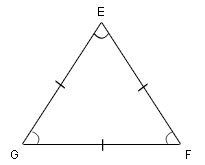
Triangle Properties
First Glance

Triangles are one of the fundamental figures used in geometry. It is a polygon with three vertices and three sides or edges, which are line segments. A triangle with vertices P, Q, R is denoted as triangle PQR and symbolically written as ![]() PQR. Triangles can be classified by its sides and angles.
PQR. Triangles can be classified by its sides and angles.
In Details
Triangle is one of the basic figures used in geometry. Like the rectangle and the circle, the triangle has enormous use in our practical life whether it is the structure of a bridge or holding up a shelf. Triangles are also used in reference to places that have a more-or-less triangular shape example – the Bermuda Triangle.
Before we move to classify different forms of triangles, it is important to discuss some of the essential features of a triangle.
Properties of a Triangle:
- Triangle is a three sided plane or two-dimensional figure
- The sum of the three angles of a triangle is always 180°
- In a triangle, an exterior angle equals the sum of the two interior opposite angles
Classification of a Triangle:
There are two common systems of triangle classification – the first by their sides and second by their angles. Let us first classify triangle by its sides and then by angles:

1. Scalene Triangle: Â The word Scalene came from the word meaning “uneven,” and a scalene triangle has three sides of different lengths. Not only are the three sides different but the three angles are also different.

2. Isosceles Triangle: An isosceles triangle has two sides that are equal in length, called legs and the third side is known as base. In an isosceles triangle, the angles opposite the equal sides are equal. In the above ![]() XYZ, the side XY=XZ and
XYZ, the side XY=XZ and ![]() XYZ =
XYZ = ![]() XZY, so
XZY, so ![]() XYZ is classified as an Isosceles triangle.
XYZ is classified as an Isosceles triangle.

3. Equilateral Triangle: Equilateral means “equal sides†and an equilateral triangle has three equal sides. This means that the angles are also equal and hence this form of triangle is also known as an equiangular triangle. As we know, that the sum of the interior angles of any triangle must equal 180 degrees therefore each angle of an equilateral triangle is always 60 degrees. In the above ![]() EFG, the sides EG=EF=GF and
EFG, the sides EG=EF=GF and ![]() EGF =
EGF = ![]() EFG =
EFG = ![]() FEG = 60°
FEG = 60°

1. Acute Triangle: In an acute triangle all the three angles measure less than 90 degrees.

2. Right Triangle: In a right triangle, there is one right angle, which measures exactly 90°. This implies that the other two angles will be acute. In the above figure, the right angle square has been drawn at vertex N to show a right angle.

3. Obtuse Triangle: An obtuse triangle has one internal angle greater than 90°. This implies that the other two angles will be acute. In the above ![]() RQP,
RQP, ![]() PQR is more than 90°
PQR is more than 90°
Examples

In the above triangle, sides US=UT and ![]() UTS = 70° and
UTS = 70° and ![]() UST = 70°, then
UST = 70°, then ![]() TUS = 40° as the summation of all the angles of a triangle is always equal to 180°. Thus,
TUS = 40° as the summation of all the angles of a triangle is always equal to 180°. Thus,
180° – (70° + 70°) = 140°
Moreover, as both the sides UT = US, then ![]() Â UTS is also an Isosceles triangle.
 UTS is also an Isosceles triangle.

In the above ![]() EFG, sides EG = EF = FG and
EFG, sides EG = EF = FG and ![]() Â EGF =
 EGF = ![]()  EFG =
 EFG = ![]()  GEF = 60°. These conditions imply that
 GEF = 60°. These conditions imply that ![]() EFG is an equilateral triangle.
EFG is an equilateral triangle.
If you feel you have a good understanding, move on to our Triangle Properties Test.



